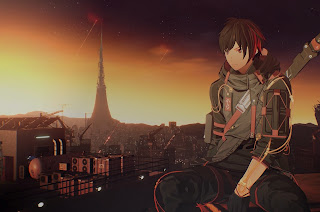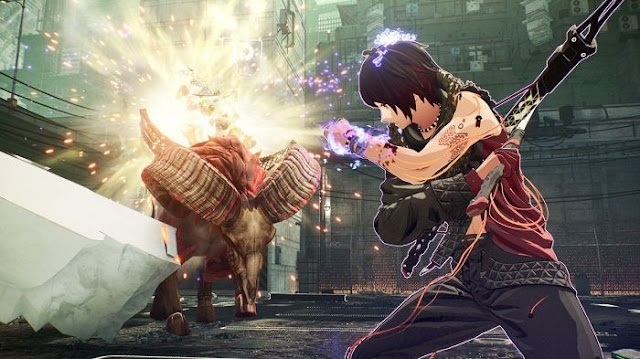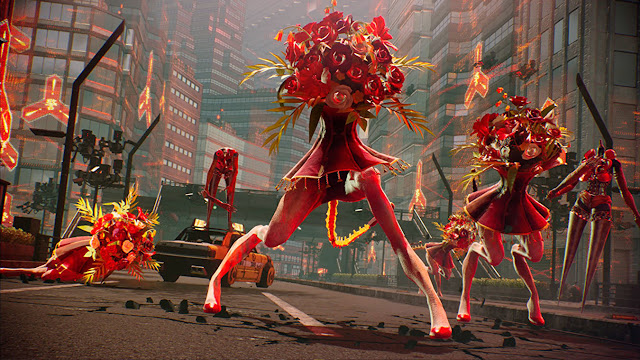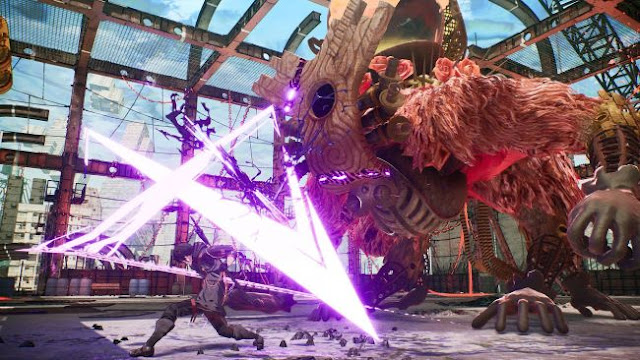The nature of reality is becoming an ever-bigger question mark that artists are grappling with, and that’s because we’re getting greater levels of control over the very foundations of the reality that we exist within. We’re taking the digital, constructed would and painting it over the physical to suit our aesthetic senses and our increasing desire to distance ourselves from reality. Scarlet Nexus is the latest entry to muse on this particular theme, and above and beyond its exceptionally good gameplay, it’s the way that it grapples its broad themes that make it the best JRPG that Bandai Namco has produced in quite some time.
The developers bill Scarlet Nexus as “brain punk,” which is an evocative genre title, though it comes with the standard disclaimer that any major corporation that creates a “-punk” game is almost certainly talking about the aesthetics of punk rather than the themes. Big corporations don’t tend to be big on the anti-establishment anger which cuts to the core of punk, after all. Nonetheless, it’s certainly dystopian, if not outright apocalyptic. In the universe of Scarlet Nexus, humanity has gained the ability to sense a kind of hyper-reality. It’s a kind of digital media space that exists beyond the physical. Corporations use our ability to see this stuff to beam advertisements into our eyeballs wherever we go (character’s muse about how nice it must be to be able to shut these senses off and be free of the endless content). Government and police forces use it to control people’s movement and section off areas that people shouldn’t be visiting.
The downside to this additional sensory capability (if the endless advertisements weren’t enough) is that a hostile alien race – the Others – are drawn to the energy created within people’s brains, and regularly attack earth to try and nab themselves a new meal. Very few people have the power to fight back against the Others, but you play as a special kind of soldier that is the exception, and has the power and abilities that allow them to fight back against these otherwise impossible foes.
Meanwhile, you’re also haunted by dreams about esoteric red strings and some truly surreal landscapes. Obviously, it would be very wrong of me to give those revelations away, as they’re central to the plot, but understanding everything that’s going on in Scarlet Nexus makes for a gripping, winding adventure that calls to mind everything from Blade Runner 2049 to the Matrix, and on to games like The Caligula Effect. To be sure, Caligula is an entirely different experience on just about every other level, but one that is equally concerned with the discourse around reality.
It’s a poignant subject, too. Just this week came the report that back here in the real world the digital clothes market will grow to $129 billion this year. People are paying as much for digital clothing from their favourite brands as they are the real deal. As we delve deeper into engagement with the digital world, “re-painting” reality to suit our aesthetic tastes, the “others” from Scarlet Nexus may well become allegorical. At least, that’s how the developers have set the game up. The places it goes from there are gripping, and no I’m not going to give them away. Let’s talk about the implications of this game down the track, but the point is, even if the game didn’t play particularly well, I would have played on just to see how it answers those questions that it raises.
Fortunately, Scarlet Nexus plays so incredibly well. Working with an all-new property, Bandai Namco clearly saw the opportunity to experiment, and this is one of those cases where all the experimentation worked. At its most basic level, Scarlet Nexus is a fast-paced action game. You run around fighting enemies with two basic attacks, as well as a dodge button. But it’s with the additional abilities where things really start to shine. You’re able to psychokinetically control objects that are scattered around the environment to use them as projectiles to attack enemies, and let me tell you, it never got old lifting a car off the ground to slam into the face of an enemy beastie.
Some other environmental objects will cause massive amounts of damage, but there aren’t many of them, and utilising them requires being successful with a quick QTE. Finally, enemies have two health bars, with the second being a kind of “shield.” If you break that, then you have the opportunity to conduct a special “finishing” move on the enemy. These finishers, as well as the environmental attacks, were particular highlights, both for the variety of them and their visceral nature. When I started using the PlayStation 5 controller last year, with its ability to apply resistance to the analogue sticks, I wasn’t a big fan, but the application of resistive triggers here to add “weight” to the really big attacks in Scarlet Nexus is a particularly effective application of the tech. I barely noticed it as I was playing, but when I started to pull the game apart, I realised that much of the visceral sensation that I was getting from the particularly powerful attacks was coming from felling actual physical feedback.
One final gameplay element that you’ll need to master is your ability to borrow the powers of your allies. By “brain-linking” with each ally you can, for a time, access and use their own special abilities. For some allies this means relatively simple “power-ups”, like giving you the ability to add electricity or fire to your own character’s attacks. At other times it will super-power your psychokinesis, or see enemies that are otherwise invisible. This is, effectively, a magic system, but it’s dynamic to the other characters in your party, and that makes you pay close attention to them and their role in combat.
This brings me to another feature that I love about Scarlet Nexus; characterisation. Bandai Namco has always been great with the characters (the banter in the Tales series has been the one most enduring reason to continue playing them), and Scarlet Nexus takes that expertise to another level entirely. One of the key “levelling” mechanisms is a Persona-like social link system, where spending more time with particular characters will deepen your bonds with them, and that will, in turn, grant you greater powers when you’re adventuring with them. Beyond the gameplay utility, however, you’ll want to spend time with these characters because, for such a consistently grim and dark story, the lighter moments of interactions between characters are hugely entertaining. For just one early example, Kasane Randall – the female protagonist – spends the first few hours of the story more focused on making sure that a boy that her sister is interested in is an honourable chap than anything else. The others are almost background noise to that little mission of hers.
If there are any criticisms of Scarlet Nexus, they are incredibly minor, but there are two that spring to mind. The first is that the game is very anime, and Bandai Namco is pitching this at a more mainstream audience than is usual. It’s not fanservicey by any means, but I can see people who aren’t typically JRPG fans picking this up, as it is a major new-gen release that Microsoft in particular dedicated real resources to, and becoming quite confused when it’s not as self-serious as a western studio would handle the same subject material. The other issue is a minor gameplay one: I felt that perspective could be a little difficult at times. I ended up missing a fair few of my character’s regular attacks because I was struggling to gauge the distance with which she could fire. Of course, this really is an incredibly minor issue in a game that wants you to make like Scarlet Witch and just hurl the environment around, but I’d be remiss if I didn’t mention that there are action games out there that do a better job with perspective.
I will just wrap this review up by making the point that it’s often said that the start of a new console generation is where the innovation happens. The back end is when developers rely on existing properties, but the first half is where they try new things, try to establish new kinds of games, and generally experiment more. Scarlet Nexus is one of the few games to have actually done that this generation. It’s not just that it’s an all-new name on the box. There’s a lot of experimentation that has gone into the game itself, from the dynamic visual novel-like cut scenes, to the (stunning, distinctive) world design and the way that the game itself plays. It’s familiar enough, but it’s also very different, and hopefully there are elements in this title that the other JRPG developers take notes on for their own work. This one deserves to be influential.
Scarlet Nexus is one of the most interesting new JRPGs that we’ve seen in a while from a big publisher. Combining a beautifully elegant, but also visceral combat system with a rich and evocative theme, and hugely entertaining characters, this game is available on the previous generation, I know, but in design and execution, it’s very much the perfect new-generation experience.
– Matt S.
Editor-in-Chief
Find me on Twitter: @mattsainsb











